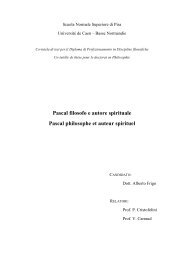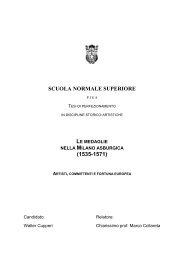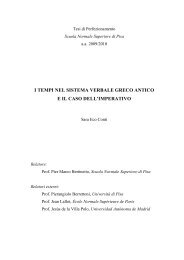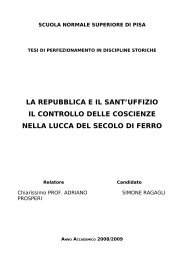CATULLUS 68 - Scuola Normale Superiore
CATULLUS 68 - Scuola Normale Superiore
CATULLUS 68 - Scuola Normale Superiore
You also want an ePaper? Increase the reach of your titles
YUMPU automatically turns print PDFs into web optimized ePapers that Google loves.
a term of endearment, albeit a somewhat extravagant one (Lucil. 730 Marx cum mei me adeunt seruuli, non<br />
dominam ego appellem meam). After Catullus the word is used in this sense by Gallus in the Qaṣr Ibrîm<br />
fragment (frg. 4.1f. FPL 3 ṭaṇdem fecerunt c ̣[ar]mina Musae / quae ̣ ̣ ̣ pọ<br />
ssem ̣ domina deicere digna mea) and it<br />
becomes common in poetry from the Augustan period onwards, also in erotic elegy (Hor. Od. 2.12.13, Tib.<br />
2.3.5, Prop. 1.1.21, Ov. Am. 1.4.47, Mart. 6.71.6, etc.; see further OLD s.v. 3b with 3a and TLL 5.1.1938.1-<br />
26 with 35-41, and see also on erae in line 136 below). Since there are parallels for both uses of domina,<br />
they do not help to answer our question and we must take a closer look at the poem to decide what this word<br />
might mean. For convenience’s sake I quote the present passage:<br />
<strong>68</strong> isque domum nobis isque dedit dominam [or –ae with Fröhlich]<br />
69 ad quam communes exerceremus amores<br />
The matter stands or falls with how one interprets the words ad quam. It is natural to assume that the<br />
antecedent of the relative quam is the last noun before it, that is, dominam (Fröhlich’s conjecture dominae<br />
does not go well with this interpretation). In this case ad quam would have to mean ‘at whose place’, ‘in<br />
whose house’, chez quoi, which is a well-established usage (see below); and since the house evidently does<br />
not belong to Lesbia, the domina would have to be identified with an anonymous chatelaine. It follows that<br />
in order to identify the domina with Catullus’ mistress one either has to take ad quam to refer back to<br />
something or somebody other than the domina, or one has to write something else in its place.<br />
In fact, it is not impossible for a relative pronoun to be further removed from its antecedent: this is the case<br />
in Pl. Epid. 55 et is danista aduenit una cum eo, qui argentum petit and in Cat. 102.1f. si quicquam tacito<br />
commissum est fido ab amico, / cuius sit penitus nota fides animi. Evidently it is possible to separate the<br />
antecedent from the relative pronoun, especially in contexts where the tone is colloquial, or worse (Fordyce<br />
has rightly censured Catullus’ carmen 102 for its slapdash quality). Thus one can look for an antecedent for<br />
the relative pronoun earlier in the sentence. There present themselves two candidates, is, that is, Catullus’<br />
friend Allius, and domum; however, the text as it stands does not easily allow for quam to be taken with<br />
domum, which is not the last word in the feminine preceding it, and it does not allow at all for it to be taken<br />
with is, which is in the masculine. If one identifies its antecedent with is, one must evidently write ad quem,<br />
which was conjectured by Baehrens; there is also a remote possibility that this is the reading of O (see ad<br />
loc.). This would result in the following text:<br />
<strong>68</strong> isque domum nobis isque dedit dominam [or –ae with Fröhlich]<br />
69 ad quem communes exerceremus amores<br />
That would be very awkward Latin, not only because of the distance between the antecedent and the relative<br />
pronoun, but also because such a relative clause would have no raison d’être: the effects of a gift<br />
182






